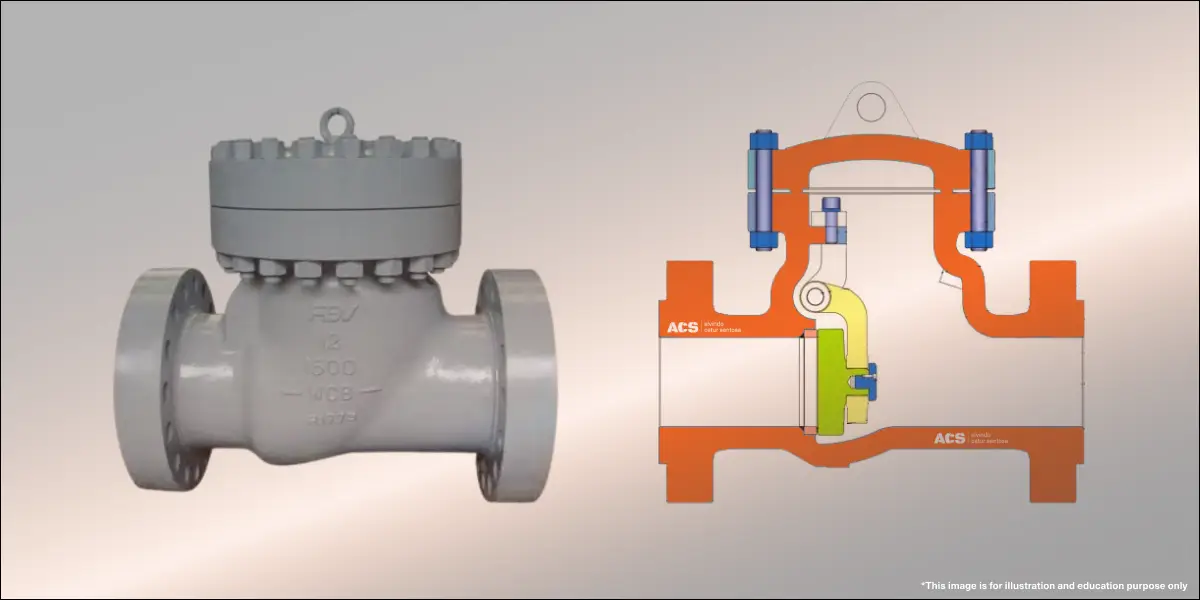Check valve is a type of valve that is widely used in various industries. You could say, this type of valve has a specific use, namely preventing backflow in the piping system. Then, how can a check valve do this?
This article will discuss how check valves work, types, applications, and how to install check valves, as well as the advantages and disadvantages of check valves. By understanding these topics, you will be able to recognize the importance of check valves in the plumbing industry and how to choose the right type for a particular application. Apart from that, you are also expected to carry out good maintenance to ensure optimal and efficient performance.
What is a Check Valve?
A check valve or what is also often referred to as a one-way valve or NRV (Non-return valve) is a component in a piping system that is designed to regulate the flow of liquid or gas in one particular direction. The main function of the check valve is to prevent backflow of liquid or gas into the system when the normal flow stops or reverses direction.
Check valves work on a simple principle: when the pressure of a liquid or gas flow moves in the direction of the valve’s design, the valve opens, allowing flow. However, if there is back pressure or reverse flow, the check valve will close automatically, stopping flow in the undesired direction.
How Check Valves Work
The main function of a check valve is to prevent backflow and allow fluid flow in only one direction. The working principle is based on the pressure difference on both sides, namely the inlet (in) side and the outlet (out) side.
When fluid flows from the inlet side to the outlet side, the valve will open because the fluid pressure is greater than the inlet side. However, when fluid tries to flow from the outlet side to the inlet side, the valve will close automatically due to the pressure difference. The way the check valve works is important because it can prevent damage to components and prevent the risk of accidents.
Types of Check Valves
Check valves have several different types depending on their needs and function. The differences in check valve types are generally based on the type of disk used. The most commonly used types of check valves are:
Swing Type
Swing check valves usually consist of a valve body, bonnet, and disk connected to a hinge. This valve moves when there is flow through the channel and will be fully closed when there is no flow. When the flow stops, the disk closes automatically with no manual assistance involved in the process. Turbulence and pressure drop in this valve are relatively very low.
In a swing check valve, the angle between the seat and the vertical plane is known as the seat angle and varies from 0 to 45°. Usually, the seat angle is in the range of 5° to 7°. The larger seat angle reduces disk movement, resulting in fast closing, thereby minimizing the possibility of water hammer.
Elevator Check Valve
The seat design on a lift check valve is generally similar to that on a globe valve and the disk uses a piston or ball. Lift check valves are very suitable for situations with high pressure and flow velocity because the disk is in contact with the seat as a whole. Lift check valves are suitable for horizontal or vertical pipe installations with upward flow.
The way it works, when the flow enters from under the seat, the disk is lifted from the seat by the upward pressure of the flow. When the flow stops or reverses direction, the reverse flow and gravity will push the disc down and compress the seat.
This valve has characteristics, namely very good leak resistance compared to swing check valves. The lift check valve that uses a ball works very simply because it works based on the principle of gravity. When there is enough pressure in the flow, the ball will rise, but when the pressure decreases, the ball will close the hole.
Dual Disc Check Valve
Dual disc check valves are known as butterfly check valves, folding disc check valves, double-disc, or splits disc check valves. As the name suggests, the way this type works is that the two parts of the open disk move towards the center line of the pipe with forward flow, and when the flow is reversed, the two parts of the disk will open away from the center line of the pipe and press the seat to close the flow. This is usually called flapping action.
Penggunaan dual plate check valve populer pada kondisi cairan atau gas bertekanan rendah. Konstruksinya yang ringan dan padat menjadikannya jenis ini menjadi pilihan yang lebih disukai dalam aspek ruang dan kenyamanan.
Tipe ini 80 hingga 90% lebih ringan dari full-body check valve konvensional dan sering digunakan dalam sistem yang menggunakan butterfly valve. Biaya instalasi dan pemeliharaan juga sangat rendah dibandingkan dengan jenis lain.
Stop Check Valve
Stop Check Valve is a combination of lift check valve and globe valve. This valve can be closed with the help of a stem that is not connected to the valve disk under normal circumstances, making it possible to use this valve as an ordinary check valve. However, if necessary a stem is used to hold the free floating disk on the valve seat, just like a globe valve.


